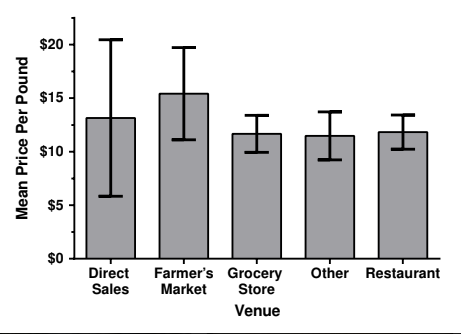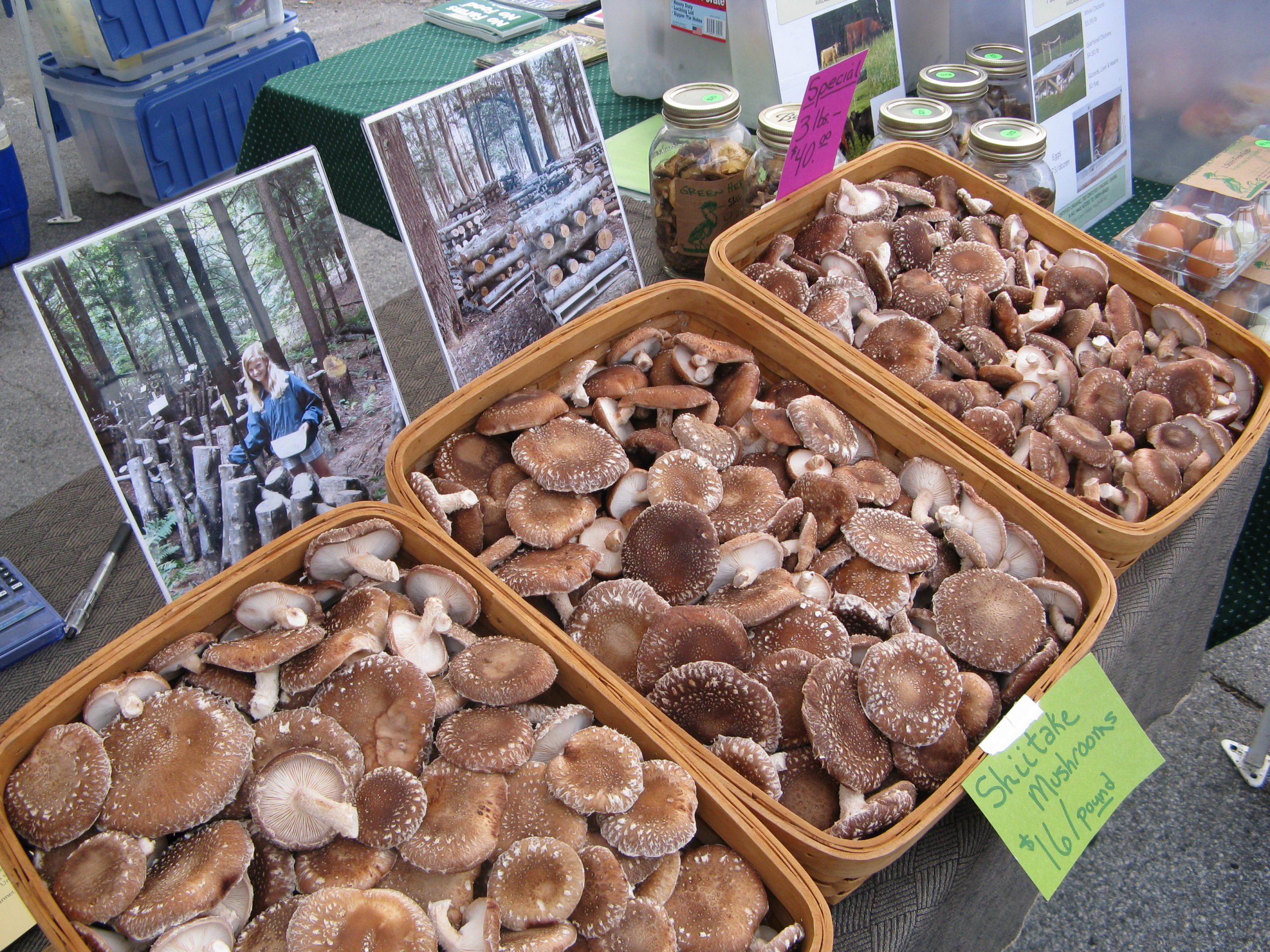Marketing Forest-Grown Shiitake
Sales Venues and Pricing
EXPERT TIPS: Develop a Local Market.
“We took advantage of our local newspaper and had an article published this week. Free PR. When I stopped in the village to grab my daily dose of caffeine, I had four people tell me they saw the article and each were interested. I would recommend using your local papers for PR to anyone on this list.”
-Matt Anderson, Tyrrel Mushrooms Farm
EXPERT TIPS: Pricing
“I dropped off half a dozen pint containers (about 0.25 pound each) at a local farmstand owned by a friend of mine (in southern Sullivan County, N.Y.) which we priced at $6.50 (26.50 per pound), and they sold out in a few hours.
Steve Kosmacher
EXPERT TIPS: Product Labels
Volume quantities do not need to be exact in terms of weight per volume sold, whereas products sold by weights need to have certified scales, according to some states’ regulations. weights can still be communicated, but it can be stated on labels or verbally that weights are rough. For example, one basket is roughly 0.25 pound of mushrooms.
Growers can sell their mushrooms at many different venues. You can receive the highest price per pound at farmers markets (approximately $15 to $20 per pound, depending on your location and distance from New York and other large cities).
However, you’ll also be required to spend more time selling the mushrooms. Most growers prefer to sell their mushrooms through direct on-farm sales (like a farmstand), grocery stores and restaurants; through these type of venues, growers tend to get a little less - approximately $12 to $13 per pound when sold in wholesale volume.
RESEARCH: Price Per Pound
You can see the actual prices which farmers in the northeast sold their mushrooms. Error bar indicates one standard deviation. On average, farmers sold their mushrooms for $13/lb at grocery stores, restaurants and direct sales, and about $15/lb at farmers markets.

EXPERT TIPS: Farmer’s Market Displays
“We started out displaying our shiitake in nice baskets with a $16/pound sign, like in this photo. Sales were slow! We quickly switched to putting 1/4 pound in balsa wood pint baskets for $4 and 1/2 pound in quarts for $8. Much better! Next we quit bringing the scale to the market and wasting time being exact about weight and started selling by volume with pint and quarters for $4 or $8. Some days we have heavier/wetter mushrooms and we don’t get our $16/ pound, but it averages out just fine. A fun thing we like to do for markets is to bring a fruiting log for display. Kids love this and it starts many conversations! Sometimes the customer cuts the last pint of the day off the sample log. They definitely go home and tell someone about this.“
- Steve and Julie Rockcastle, Green Heron Farms
EXPERT TIPS: Working with Restaurants
“When I approach restaurants, I bring along a small flyer that has photos of the logs so they get a sense of growing methods and also text which explains some generalities of log-grown superiority over sawdust-grown (taste, nutrition, texture, storage). I also give them a small sample to try with the staff. This is often all it takes, but I only approach restaurants that I think really get the concept of quality ingredients. I have approached 15 restaurants and successfully marketed to 12, now my “regulars”. My higher prices were the main factor for the 3 who did not take my shiitakes.
“You really want to make the life of the restaurant person as easy as possible. If you take on a restaurant account, you have to make sure, as best you can, that you have an assured supply of high quality, fresh shiitakes and deliver when they need them. I now know the menu-planning habits, best buying days and best delivery times for all my accounts and try to reasonably fit into that the best I can. Some accounts have come right out and said to me that they know they can get log-grown shiitakes cheaper elsewhere but they like my assured supply and commitment to quality. With a few accounts I feel like part of their ‘family’ now.“
- Steve Sierigk, Hawk Meadow Farm
EXPERT TIPS: Selling Inoculated Logs
“I have been selling some logs during the autumn for $35 each. However, I think that selling them in May as “ready-to-fruit logs” would result in a lot more sales. I have had a lot of people asking me why I was selling them this fall and they seem very concerned about caring for them over the winter. So, I would suggest selling logs in the spring. As far as a price goes, you can do some Internet research and find that logs are selling for $30 to $40-plus and they are 12 to 18 inches long on the internet.
- Matt Anderson, Tyrrel Mushroom Farm
“I encourage people to get multiples as they would be more likely to look after them than if it were just one. New this year I started to advertise ... the purchase of your own mini shiitake yard ... I only had enough logs to sell 3 of these. This included 14 of these smaller logs, where you could force 2 each week for a 7-week cycle to get yourself a steady supply of shiitakes. I sold these for $225 and it came with a 30-minute consult. I easily sold 3 sets like this and this was a great way to go. I could probably increase the price here, too, but there is a certain efficiency in dealing all with one person and building a long term relationship as these folks will look to recharge logs soon enough. They quickly become the envy of their neighborhood and people will look to get their own.”
- Steve Sierigk, Hawk Meadow Farm
Ideas to Help Develop a Market
General Tips
- How to compete with $7 to $8 per pound sawdust-grown shiitake mushrooms? Keep communication open about the virtues of log-grown. Better taste, higher beta-glucan levels, superior freshness and shelf life, etc. Also, the process of growing log-grown can be highlighted. It is part of an overall sustainable forest management strategy, not just a production assembly line.
- Make sure that the mushrooms you are selling are always top quality.
- Try to be consistent with delivery times and quantities. If you have promised a certain amount of product, make sure your rotation schedule reflects this.
- Collect e-mail addresses and keep communication flowing. Certain customers will want to stay in the loop about your mushroom production and availability of different types of mushrooms (e.g., “grillers” vs. small caps for stir-frys).
- Some people prefer very large mushrooms for burgers and grilling, some prefer smaller ones. Consumers have varying preferences.

At Farmers Markets
- Offer free samples, recipes or pamphlets to help customers realize how tasty and fun mushrooms can be.
- Start with smaller price tags. For example $4 per quarter pound versus $16 per pound.
- Selling by the basket works well. Baskets can be expensive, but $5, $10, or $20 per basket simplifies the purchasing process for consumers.
- Thursdays and Fridays are days of high demand, coming into the weekend, when people are more festive with their food.
- Most growers do not separate caps from stems. Some experimented with selling “caps-only” mushrooms for a premium price.
- Consider rewarding your regular buyers.
RESEARCH: Consumer Preferences
A survey was conducted at the Trumansburg Farmer’s Market aimed at exploring the perceptions and behaviors of consumers who purchase mushrooms. Based on this survey, researchers determined the following:
- consumers indicated that they were more likely to purchase fresh mushrooms, rather than dried.
- consumers indicated they that would be more likely to purchase and pay more for a food with greater heath or medical benefits (functional food)
- consumers indicated they had the most confidence in a health claim made in the scientific literature, followed by a medical professional.
This means that if a farmer in a farmer’s market is advertising the health benefits of their products, then they should be sure to include the source of their claims for improved authority and trustworthiness.
(adapted from thesis research by B. Sobel (2013) of Cornell University)
At Restaurants
- Talk with local chefs to see if they might be interested in your product. It’s nice if you have some information to leave them; be sure that your contact information is clearly visible.
- Ask if they would like you to provide sample products.
- If certain restaurants are willing to buy particularly large quantities, consider offering a bulk discount.
At Grocery Stores
- Stores that put emphasis on buying locally or eating healthy foods are good choices for your product. At the right venue, your buyers will be pleased to sell a great product that makes their store look good to consumers.
Selling Inoculated Logs
In addition to selling shiitake mushrooms, growers may also want to consider selling inoculated shiitake logs to mushroom hobbyists. To entice potential buyers, we recommend selling “ready-to-fruit” logs; the buyer can go home, soak it, and get mushrooms a week later. We also recommend that these logs be smaller than the ones used in a commercial operation - anywhere between 12 to 28 inches is normal.

